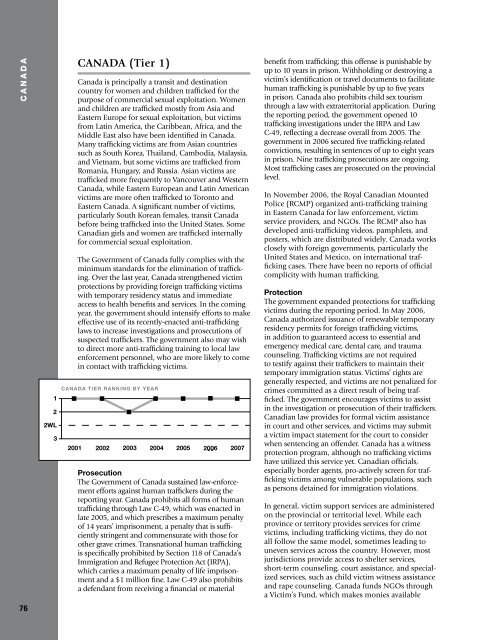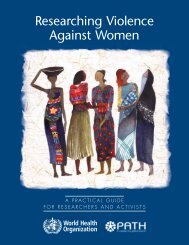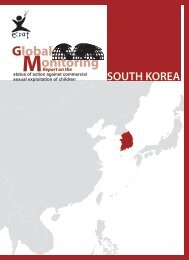2007 Trafficking in Persons Report - Center for Women Policy Studies
2007 Trafficking in Persons Report - Center for Women Policy Studies
2007 Trafficking in Persons Report - Center for Women Policy Studies
Create successful ePaper yourself
Turn your PDF publications into a flip-book with our unique Google optimized e-Paper software.
C A N A D A<br />
76<br />
CANADA (Tier 1)<br />
Canada is pr<strong>in</strong>cipally a transit and dest<strong>in</strong>ation<br />
country <strong>for</strong> women and children trafficked <strong>for</strong> the<br />
purpose of commercial sexual exploitation. <strong>Women</strong><br />
and children are trafficked mostly from Asia and<br />
Eastern Europe <strong>for</strong> sexual exploitation, but victims<br />
from Lat<strong>in</strong> America, the Caribbean, Africa, and the<br />
Middle East also have been identified <strong>in</strong> Canada.<br />
Many traffick<strong>in</strong>g victims are from Asian countries<br />
such as South Korea, Thailand, Cambodia, Malaysia,<br />
and Vietnam, but some victims are trafficked from<br />
Romania, Hungary, and Russia. Asian victims are<br />
trafficked more frequently to Vancouver and Western<br />
Canada, while Eastern European and Lat<strong>in</strong> American<br />
victims are more often trafficked to Toronto and<br />
Eastern Canada. A significant number of victims,<br />
particularly South Korean females, transit Canada<br />
be<strong>for</strong>e be<strong>in</strong>g trafficked <strong>in</strong>to the United States. Some<br />
Canadian girls and women are trafficked <strong>in</strong>ternally<br />
<strong>for</strong> commercial sexual exploitation.<br />
The Government of Canada fully complies with the<br />
m<strong>in</strong>imum standards <strong>for</strong> the elim<strong>in</strong>ation of traffick<strong>in</strong>g.<br />
Over the last year, Canada strengthened victim<br />
protections by provid<strong>in</strong>g <strong>for</strong>eign traffick<strong>in</strong>g victims<br />
with temporary residency status and immediate<br />
access to health benefits and services. In the com<strong>in</strong>g<br />
year, the government should <strong>in</strong>tensify ef<strong>for</strong>ts to make<br />
effective use of its recently-enacted anti-traffick<strong>in</strong>g<br />
laws to <strong>in</strong>crease <strong>in</strong>vestigations and prosecutions of<br />
suspected traffickers. The government also may wish<br />
to direct more anti-traffick<strong>in</strong>g tra<strong>in</strong><strong>in</strong>g to local law<br />
en<strong>for</strong>cement personnel, who are more likely to come<br />
<strong>in</strong> contact with traffick<strong>in</strong>g victims.<br />
Prosecution<br />
The Government of Canada susta<strong>in</strong>ed law-en<strong>for</strong>cement<br />
ef<strong>for</strong>ts aga<strong>in</strong>st human traffickers dur<strong>in</strong>g the<br />
report<strong>in</strong>g year. Canada prohibits all <strong>for</strong>ms of human<br />
traffick<strong>in</strong>g through Law C-49, which was enacted <strong>in</strong><br />
late 2005, and which prescribes a maximum penalty<br />
of 14 years’ imprisonment, a penalty that is sufficiently<br />
str<strong>in</strong>gent and commensurate with those <strong>for</strong><br />
other grave crimes. Transnational human traffick<strong>in</strong>g<br />
is specifically prohibited by Section 118 of Canada’s<br />
Immigration and Refugee Protection Act (IRPA),<br />
which carries a maximum penalty of life imprisonment<br />
and a $1 million f<strong>in</strong>e. Law C-49 also prohibits<br />
a defendant from receiv<strong>in</strong>g a f<strong>in</strong>ancial or material<br />
benefit from traffick<strong>in</strong>g; this offense is punishable by<br />
up to 10 years <strong>in</strong> prison. Withhold<strong>in</strong>g or destroy<strong>in</strong>g a<br />
victim’s identification or travel documents to facilitate<br />
human traffick<strong>in</strong>g is punishable by up to five years<br />
<strong>in</strong> prison. Canada also prohibits child sex tourism<br />
through a law with extraterritorial application. Dur<strong>in</strong>g<br />
the report<strong>in</strong>g period, the government opened 10<br />
traffick<strong>in</strong>g <strong>in</strong>vestigations under the IRPA and Law<br />
C-49, reflect<strong>in</strong>g a decrease overall from 2005. The<br />
government <strong>in</strong> 2006 secured five traffick<strong>in</strong>g-related<br />
convictions, result<strong>in</strong>g <strong>in</strong> sentences of up to eight years<br />
<strong>in</strong> prison. N<strong>in</strong>e traffick<strong>in</strong>g prosecutions are ongo<strong>in</strong>g.<br />
Most traffick<strong>in</strong>g cases are prosecuted on the prov<strong>in</strong>cial<br />
level.<br />
In November 2006, the Royal Canadian Mounted<br />
Police (RCMP) organized anti-traffick<strong>in</strong>g tra<strong>in</strong><strong>in</strong>g<br />
<strong>in</strong> Eastern Canada <strong>for</strong> law en<strong>for</strong>cement, victim<br />
service providers, and NGOs. The RCMP also has<br />
developed anti-traffick<strong>in</strong>g videos, pamphlets, and<br />
posters, which are distributed widely. Canada works<br />
closely with <strong>for</strong>eign governments, particularly the<br />
United States and Mexico, on <strong>in</strong>ternational traffick<strong>in</strong>g<br />
cases. There have been no reports of official<br />
complicity with human traffick<strong>in</strong>g.<br />
Protection<br />
The government expanded protections <strong>for</strong> traffick<strong>in</strong>g<br />
victims dur<strong>in</strong>g the report<strong>in</strong>g period. In May 2006,<br />
Canada authorized issuance of renewable temporary<br />
residency permits <strong>for</strong> <strong>for</strong>eign traffick<strong>in</strong>g victims,<br />
<strong>in</strong> addition to guaranteed access to essential and<br />
emergency medical care, dental care, and trauma<br />
counsel<strong>in</strong>g. <strong>Traffick<strong>in</strong>g</strong> victims are not required<br />
to testify aga<strong>in</strong>st their traffickers to ma<strong>in</strong>ta<strong>in</strong> their<br />
temporary immigration status. Victims’ rights are<br />
generally respected, and victims are not penalized <strong>for</strong><br />
crimes committed as a direct result of be<strong>in</strong>g trafficked.<br />
The government encourages victims to assist<br />
<strong>in</strong> the <strong>in</strong>vestigation or prosecution of their traffickers.<br />
Canadian law provides <strong>for</strong> <strong>for</strong>mal victim assistance<br />
<strong>in</strong> court and other services, and victims may submit<br />
a victim impact statement <strong>for</strong> the court to consider<br />
when sentenc<strong>in</strong>g an offender. Canada has a witness<br />
protection program, although no traffick<strong>in</strong>g victims<br />
have utilized this service yet. Canadian officials,<br />
especially border agents, pro-actively screen <strong>for</strong> traffick<strong>in</strong>g<br />
victims among vulnerable populations, such<br />
as persons deta<strong>in</strong>ed <strong>for</strong> immigration violations.<br />
In general, victim support services are adm<strong>in</strong>istered<br />
on the prov<strong>in</strong>cial or territorial level. While each<br />
prov<strong>in</strong>ce or territory provides services <strong>for</strong> crime<br />
victims, <strong>in</strong>clud<strong>in</strong>g traffick<strong>in</strong>g victims, they do not<br />
all follow the same model, sometimes lead<strong>in</strong>g to<br />
uneven services across the country. However, most<br />
jurisdictions provide access to shelter services,<br />
short-term counsel<strong>in</strong>g, court assistance, and specialized<br />
services, such as child victim witness assistance<br />
and rape counsel<strong>in</strong>g. Canada funds NGOs through<br />
a Victim’s Fund, which makes monies available
















